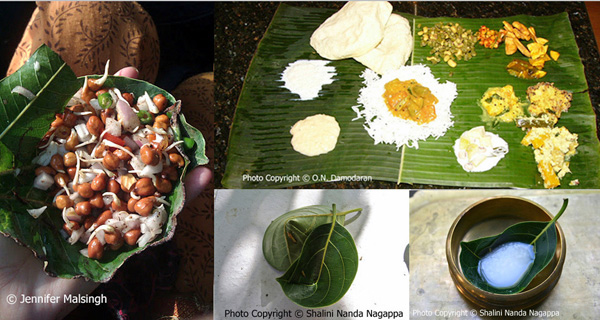August 28, 2012

For centuries Indians have used large and small leaves of specific trees, plants and vines for cooking, serving and packaging food. These leaves range from large banana leaves to small jackfruit tree leaves, banyan leaves and palash leaves (Butea monosperma). In times past even leaves of the teak tree were used for serving food. The smaller leaves are pieced together to make disposable plates and bowls.
Green Leaves for Plates
One of the essential traits of south Indian feasts is banana leaves used as plates. Banana leaf is one of the most eco-friendly, disposable dinnerware. The leaf makes an attractive serving platter because of its size and sturdiness. It requires little cleaning; a simple sprinkling of water and wiping is enough to clean a banana leaf and it is waterproof. The leaves can be quite big and there is plenty of room to present a variety of dishes. Besides being environmentally friendly, the banana leaf helps retain the flavor, aroma and nutritional value of the food placed on it.
In the old days, people sat cross-legged on a straw mat or a wooden plank and food was served on a banana leaf placed on the floor in front of each diner. There are specific places for each of the dishes on the banana leaf, and the servers are expected to know these rules. As soon as hot food is placed on a banana leaf, it releases a particular enzyme which enhances the flavor of the food. Banana leaves are still used for serving food, but mostly they are placed on top of a dining table. Sometimes they are cut into round shape and metal plates are lined with them. Due to the mild flavor it imparts during cooking, many recipes rely on the banana leaf as a wrapping for both steaming and grilling for the specific taste and fragrance they impart. It is also ideal for packing food and works as a great liner for steamer vessels.
Jackfruit leaves are pinned together to make good tablespoons. Pale green palash leaves are stiff and velvety to begin with, and leathery later. Palash and banyan leaves are pinned or stitched together to make plates and bowls. Just like banana leaves these leaves also impart a mild fragrance to the food served on or with them. Palash is known for its medicinal properties. According to Ayurveda, the Indian herbal medicine, eating in plates made with banana leaves, palash leaves, and banyan leaves is also good for digestion. These leaves also function as serving dishes, providing a renewable alternative to paper plates, waxed paper, foil or parchment.
Granite Dinner Plates

I learned about the most intriguing eco-friendly dinnerware used in India centuries ago – granite dinner plates- on my visit to Hampi, the final capital of Vijayanagara, the last of the great Hindu kingdoms of South India. The destruction of Vijayanagara by Muslim invaders from the north was sudden, shocking and absolute. Vijayanagara suffered heavy losses and the capital city was reduced to ruins. Its impressive remains are scattered over a large area amidst giant boulders and vegetation in central Karnataka in south India. It is now a protected UNESCO world heritage center. Every temple, every palace, and every monument silently recount the story of the grandeur of a glorious past.
One of the attractions at Hampi is the open air bhojana sala – dining hall for the masses. Just imagine a city where the king fed so many people that he had an entire area set up as a dining hall, with two rows of plates permanently set up, ready to eat in, stretching over a length of about seventy five feet in an open air facility. The plates are carved on granite slabs with circular depressions large and small for serving food. It was surprising to see even a full banana leaf and bowls carved in stone. The rows face each other with a three feet wide and two feet deep channel in the middle separating the two. Apparently, these water channels were there to help serve as well as cleanup. The serving staff would have used the dry channel to walk through and serve food. And once people finished eating, water was let in to wash the plates. The plates are also slightly tilted so they could be washed and drained quickly. Hampi had an ingenious water distribution system using open channel and gravity. The octagonal fountain, not far from the bhojana sala seems to be a control tower of the hydraulic network with six pipelines converging. The pipes were made of terracotta and used siphon technique for maintaining the pressure. Nearby Thungabhadra river supplied the abundant water supply.
The Mahanavami Festival celebrated every year at the end of the rainy season in September-October symbolized the splendor, power, and affluence of the Vijayanagara rulers. Although the festival was mainly religious, it involved a lot of common people of the region. The final event of the Mahanavami Festival was a military review in which the huge army was lined up. According to the archeologists the bhojana sala was community dining area for the soldiers and it was used as a community feast hall during the festival. With so many people to feed, perhaps it was more practical to use granite plates instead of banana leaves.